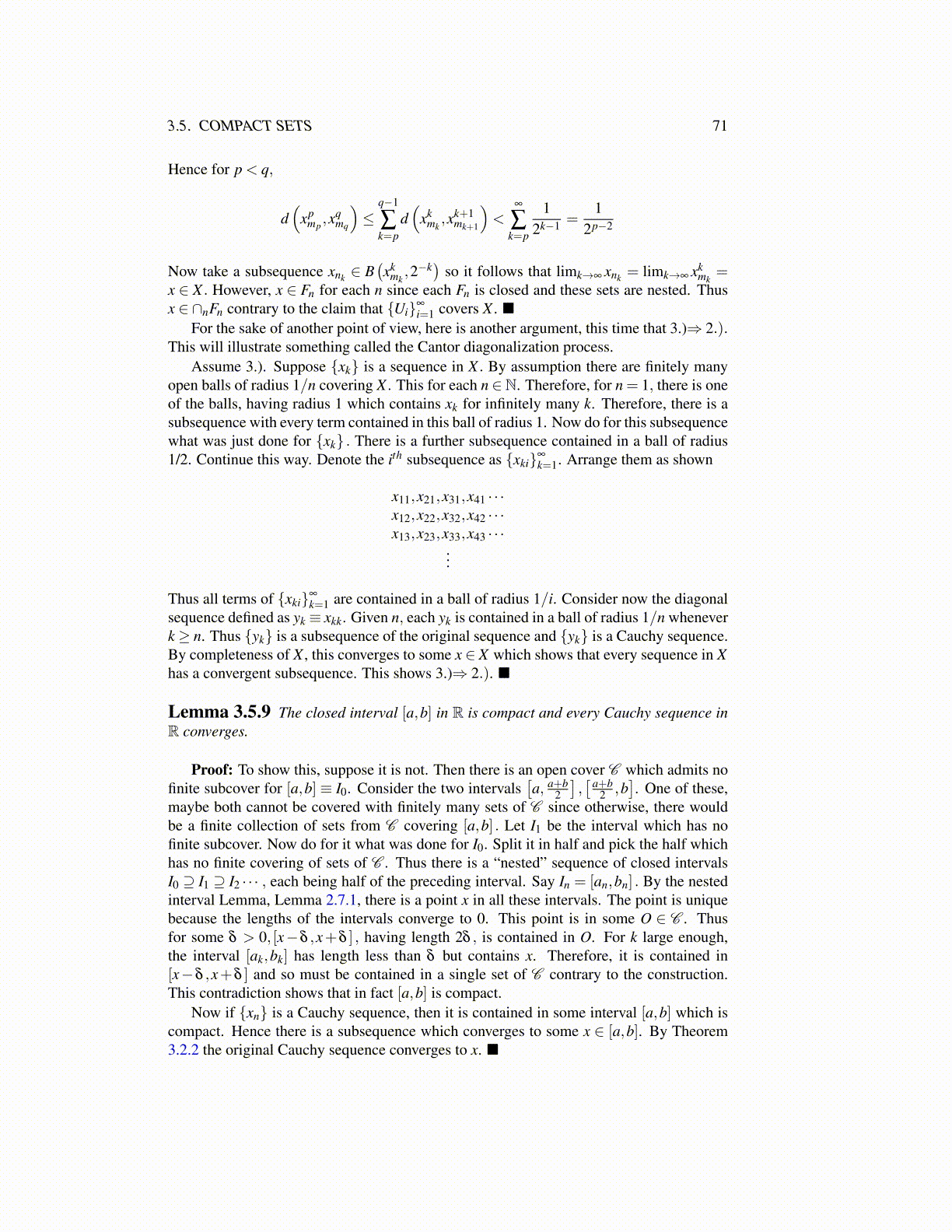
3.5. COMPACT SETS 71
Hence for p < q,
d(
xpmp ,x
qmq
)≤
q−1
∑k=p
d(
xkmk,xk+1
mk+1
)<
∞
∑k=p
12k−1 =
12p−2
Now take a subsequence xnk ∈ B(xk
mk,2−k
)so it follows that limk→∞ xnk = limk→∞ xk
mk=
x ∈ X . However, x ∈ Fn for each n since each Fn is closed and these sets are nested. Thusx ∈ ∩nFn contrary to the claim that {Ui}∞
i=1 covers X . ■For the sake of another point of view, here is another argument, this time that 3.)⇒ 2.).
This will illustrate something called the Cantor diagonalization process.Assume 3.). Suppose {xk} is a sequence in X . By assumption there are finitely many
open balls of radius 1/n covering X . This for each n ∈N. Therefore, for n = 1, there is oneof the balls, having radius 1 which contains xk for infinitely many k. Therefore, there is asubsequence with every term contained in this ball of radius 1. Now do for this subsequencewhat was just done for {xk} . There is a further subsequence contained in a ball of radius1/2. Continue this way. Denote the ith subsequence as {xki}∞
k=1. Arrange them as shown
x11,x21,x31,x41 · · ·x12,x22,x32,x42 · · ·x13,x23,x33,x43 · · ·
...
Thus all terms of {xki}∞
k=1 are contained in a ball of radius 1/i. Consider now the diagonalsequence defined as yk ≡ xkk. Given n, each yk is contained in a ball of radius 1/n wheneverk≥ n. Thus {yk} is a subsequence of the original sequence and {yk} is a Cauchy sequence.By completeness of X , this converges to some x ∈ X which shows that every sequence in Xhas a convergent subsequence. This shows 3.)⇒ 2.). ■
Lemma 3.5.9 The closed interval [a,b] in R is compact and every Cauchy sequence inR converges.
Proof: To show this, suppose it is not. Then there is an open cover C which admits nofinite subcover for [a,b] ≡ I0. Consider the two intervals
[a, a+b
2
],[ a+b
2 ,b]. One of these,
maybe both cannot be covered with finitely many sets of C since otherwise, there wouldbe a finite collection of sets from C covering [a,b] . Let I1 be the interval which has nofinite subcover. Now do for it what was done for I0. Split it in half and pick the half whichhas no finite covering of sets of C . Thus there is a “nested” sequence of closed intervalsI0 ⊇ I1 ⊇ I2 · · · , each being half of the preceding interval. Say In = [an,bn] . By the nestedinterval Lemma, Lemma 2.7.1, there is a point x in all these intervals. The point is uniquebecause the lengths of the intervals converge to 0. This point is in some O ∈ C . Thusfor some δ > 0, [x−δ ,x+δ ] , having length 2δ , is contained in O. For k large enough,the interval [ak,bk] has length less than δ but contains x. Therefore, it is contained in[x−δ ,x+δ ] and so must be contained in a single set of C contrary to the construction.This contradiction shows that in fact [a,b] is compact.
Now if {xn} is a Cauchy sequence, then it is contained in some interval [a,b] which iscompact. Hence there is a subsequence which converges to some x ∈ [a,b]. By Theorem3.2.2 the original Cauchy sequence converges to x. ■